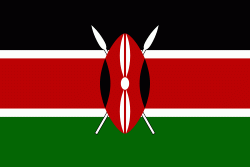Ijara District (Ijara District)
Ijara was a former administrative district in the North Eastern Province of Kenya. On May 20, 2000, it was carved out from the larger Garissa District. It covered an area of 11,332 km2 and, according to the population census of 1999, had a population of 62,571. It bordered Garissa District to the north, Lamu District to the south, Tana River District to the west, and Somalia to the northeast. The district had one local authority, Ijara county council, and one constituency, Ijara Constituency. In 2010, it was amalgamated with Garissa County.
The main economic livelihood of the inhabitants is pastoralism and subsistence agriculture. Over 80% of the land is earmarked for livestock production. There is potential for rain-fed agriculture but only a small proportion is utilized for commercial agriculture. Local communities settled in the district include the Awer hunter-gatherers and the pastoral Somali Abdalla.
Approximately one quarter of the former district is covered by the Boni Forest, which is an indigenous open canopy forest and part of Northern Zanzibar-Inhambane coastal forest mosaic. A section of the forest, the Boni National Reserve, is managed by the Kenya Wildlife Service as a protected conservation area. Other forest types are found along the Tana River on the western border of the district. The district is also pivotal in the conservation of the critically endangered Hirola population. A number of initiatives and conservancies have been established to that purpose, including the Ishaqbini Hirola Conservancy.
The main economic livelihood of the inhabitants is pastoralism and subsistence agriculture. Over 80% of the land is earmarked for livestock production. There is potential for rain-fed agriculture but only a small proportion is utilized for commercial agriculture. Local communities settled in the district include the Awer hunter-gatherers and the pastoral Somali Abdalla.
Approximately one quarter of the former district is covered by the Boni Forest, which is an indigenous open canopy forest and part of Northern Zanzibar-Inhambane coastal forest mosaic. A section of the forest, the Boni National Reserve, is managed by the Kenya Wildlife Service as a protected conservation area. Other forest types are found along the Tana River on the western border of the district. The district is also pivotal in the conservation of the critically endangered Hirola population. A number of initiatives and conservancies have been established to that purpose, including the Ishaqbini Hirola Conservancy.
Map - Ijara District (Ijara District)
Map
Country - Kenya
 |
 |
| Flag of Kenya | |
Kenya's earliest inhabitants were hunter-gatherers, like the present-day Hadza people. According to archaeological dating of associated artifacts and skeletal material, Cushitic speakers first settled in Kenya's lowlands between 3,200 and 1,300 BC, a phase known as the Lowland Savanna Pastoral Neolithic. Nilotic-speaking pastoralists (ancestral to Kenya's Nilotic speakers) began migrating from present-day South Sudan into Kenya around 500 BC. Bantu people settled at the coast and the interior between 250 BC and 500 AD. European contact began in 1500 AD with the Portuguese Empire, and effective colonisation of Kenya began in the 19th century during the European exploration of the interior. Modern-day Kenya emerged from a protectorate established by the British Empire in 1895 and the subsequent Kenya Colony, which began in 1920. Numerous disputes between the UK and the colony led to the Mau Mau revolution, which began in 1952, and the declaration of independence in 1963. After independence, Kenya remained a member of the Commonwealth of Nations. The current constitution was adopted in 2010 and replaced the 1963 independence constitution.
Currency / Language
| ISO | Currency | Symbol | Significant figures |
|---|---|---|---|
| KES | Kenyan shilling | Sh | 2 |
| ISO | Language |
|---|---|
| EN | English language |
| SW | Swahili language |















